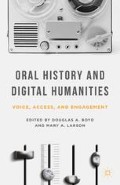Abstract
When I set out to record women’s experiences in 1972, my commitment to “recovering our past” had little to do with the oral history movement and everything to do with the women’s liberation movement. Like so many other feminists around the country who were engaging in this avowedly advocacy-oriented work, when we launched the community-based Feminist Oral History Research Project (FHRP), we had just enough money to buy some audio cassettes and pay for a post office box. We certainly did not have the money or womanpower to create transcripts. Besides, at that time, we were not primarily interested in creating an archive; we were about giving voice.
The ideas presented here are largely a result of the close collaboration with my Virtual Oral/Aural History Archive (VOAHA) partner, Kaye Briegel, who was involved from the start in its development and evolution. Ali Igmen, our successor following our respective retirements, joined in our discussions later, especially after the fatal crash of VOAHA in 2010, and in our conversations regarding migration to a new architecture. Their comments on this paper are greatly appreciated. David Bradley and Nancy Rayner were the key technical staff who crafted the process and design of the original VOAHA, with the participation of Walter Gajewski who served as an advisor on audio issues. The Academic Computer Services unit in which these staff members worked was supplanted by Academic Technology Services in the Library. Technological Strategist Jill Horn was responsible for the migration of VOAHA.
I am especially grateful to my University of Alaska Fairbanks colleagues, Karen Brewster and Will Schneider, whose insightful feedback enabled me to make meaningful comparisons between our two projects and especially helped me to dig deeper and think bigger.
Access this chapter
Tax calculation will be finalised at checkout
Purchases are for personal use only
Preview
Unable to display preview. Download preview PDF.
Notes
Raphael Samuel, “Perils of the Transcript,” Oral History, 1(2) (1972): 19. Unfortunately, in the early days, some programs not only produced heavily edited transcripts, they even recorded over the tapes.
Dennis Tedlock, “Oral History as Poetry,” in Envelopes of Sounds: The Art of Oral History, ed. Ronald Grele (New York: Praeger, 1991), 106–125;
Karen S. Harper Wilson, “In Hmong Mountain: See Lee’s Oral Narrative as History and Poetry” (master’s thesis, California State University, Long Beach [CSULB], 1995).
Louis Starr, “Oral History,” in Encyclopedia of Library and Information Service, Vol. 20 (1977), reprinted in Oral History: An Interdisciplinary Anthology (Walnut Creek, CA: Altamira Press, 1996), 42–43.
Sherna Berger Gluck, Donald A. Ritchie, and Bret Eynon, “Reflections on Oral History in the New Millennium: Roundtable Comments,” Oral History Review, 26 (2) (1999): 1–27.
Editor information
Editors and Affiliations
Copyright information
© 2014 Douglas A. Boyd and Mary A. Larson
About this chapter
Cite this chapter
Gluck, S.B. (2014). Why Do We Call It Oral History? Refocusing on Orality/Aurality in the Digital Age. In: Boyd, D.A., Larson, M.A. (eds) Oral History and Digital Humanities. Palgrave Studies in Oral History. Palgrave Macmillan, New York. https://doi.org/10.1057/9781137322029_3
Download citation
DOI: https://doi.org/10.1057/9781137322029_3
Publisher Name: Palgrave Macmillan, New York
Print ISBN: 978-1-137-32201-2
Online ISBN: 978-1-137-32202-9
eBook Packages: Palgrave History CollectionHistory (R0)

